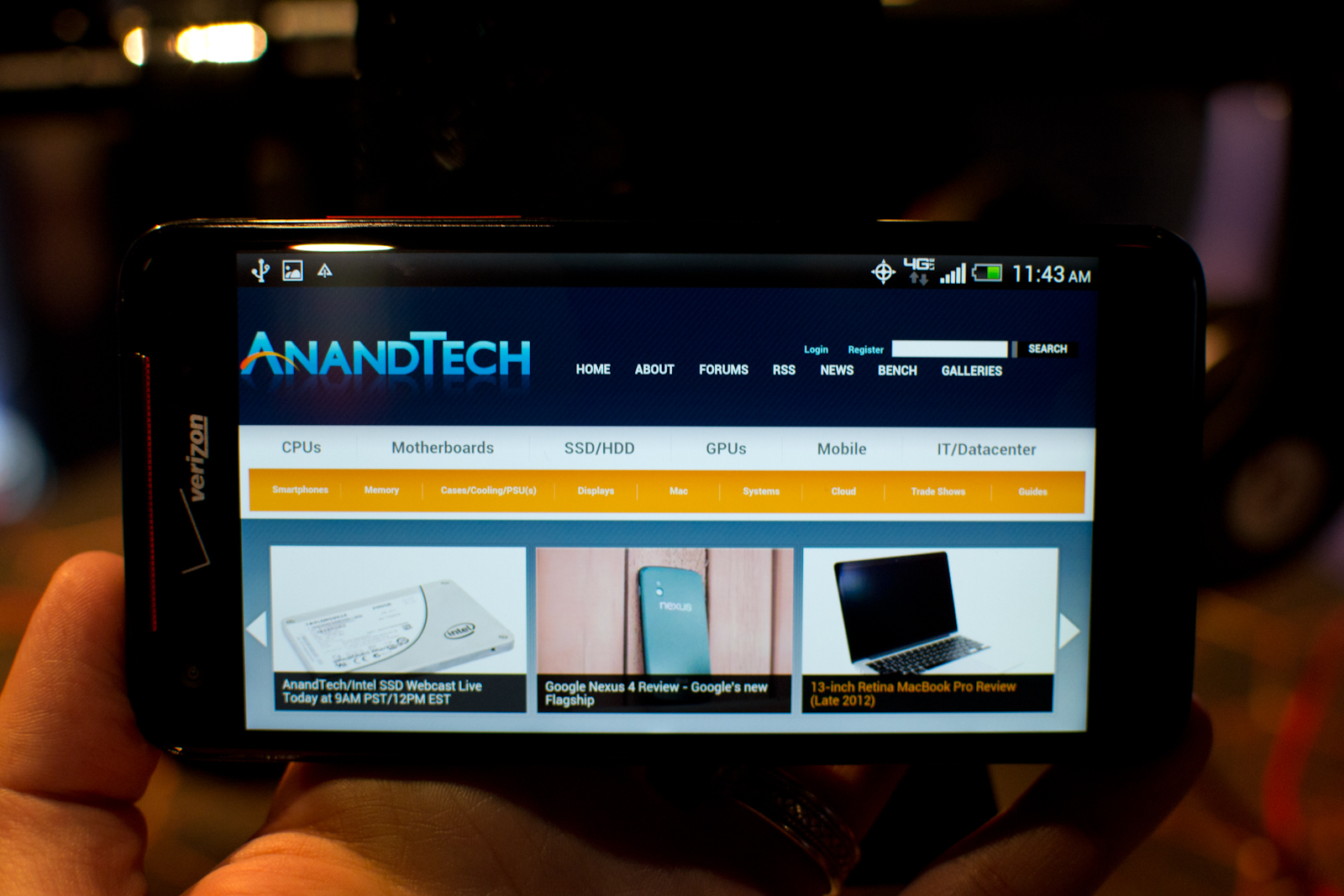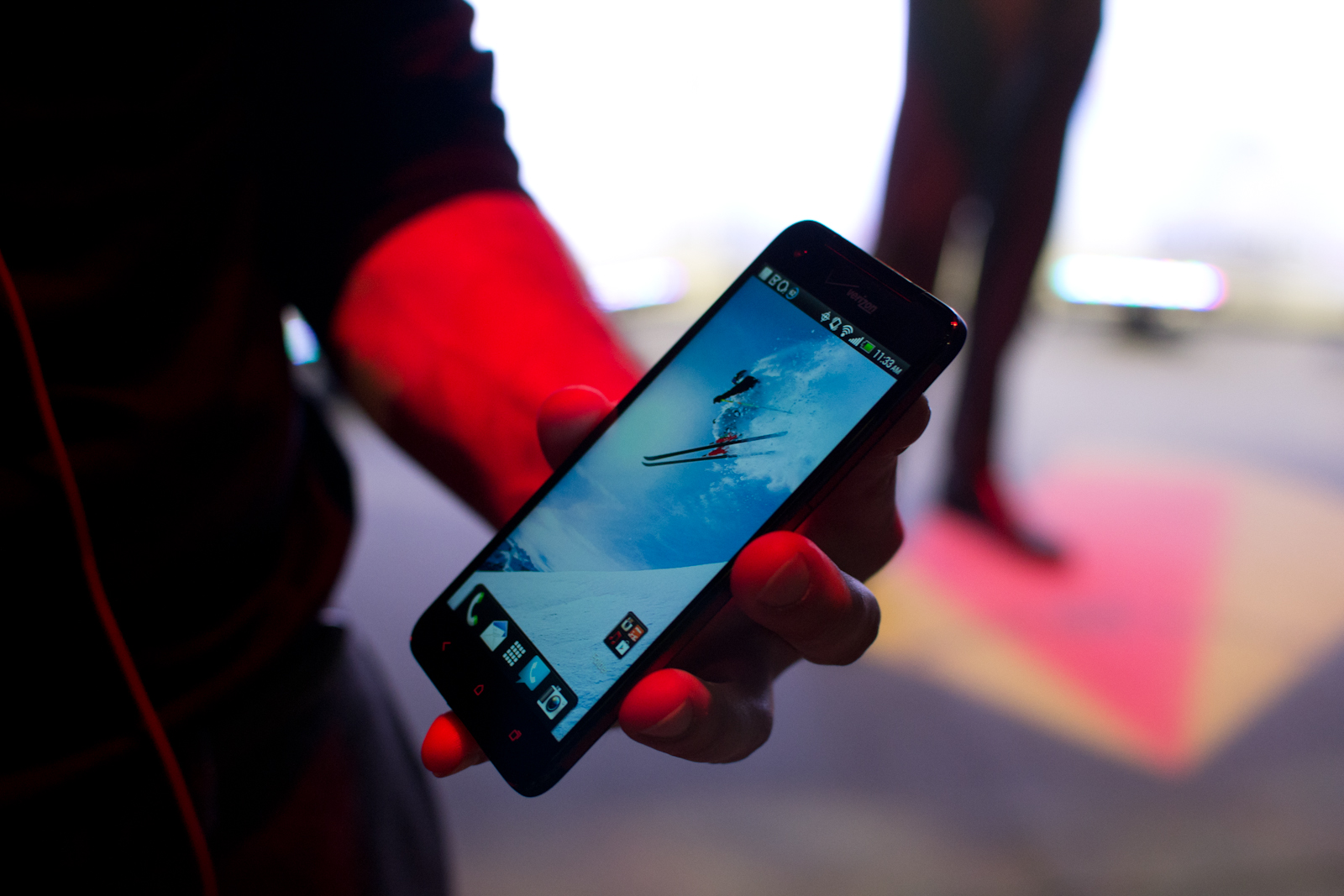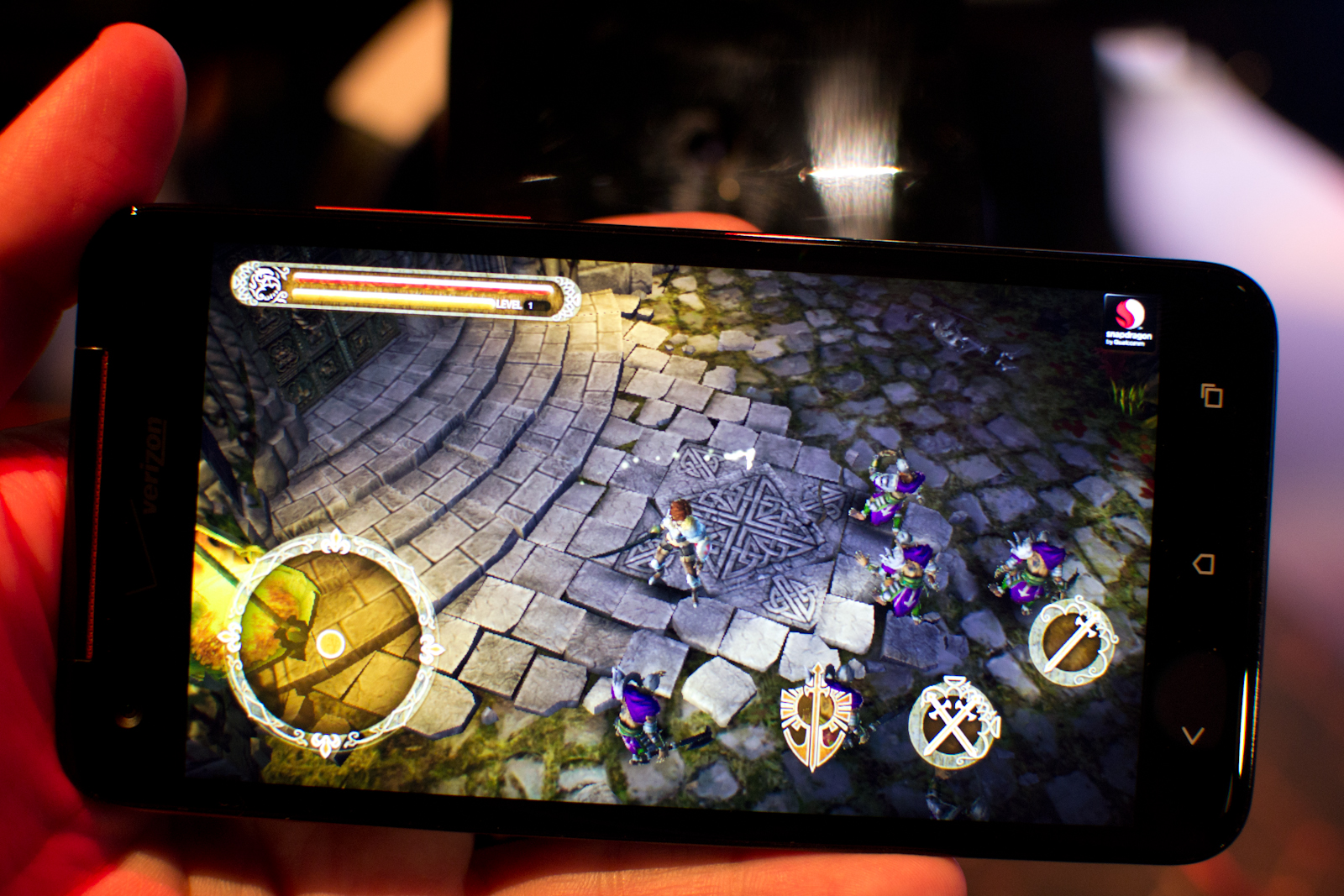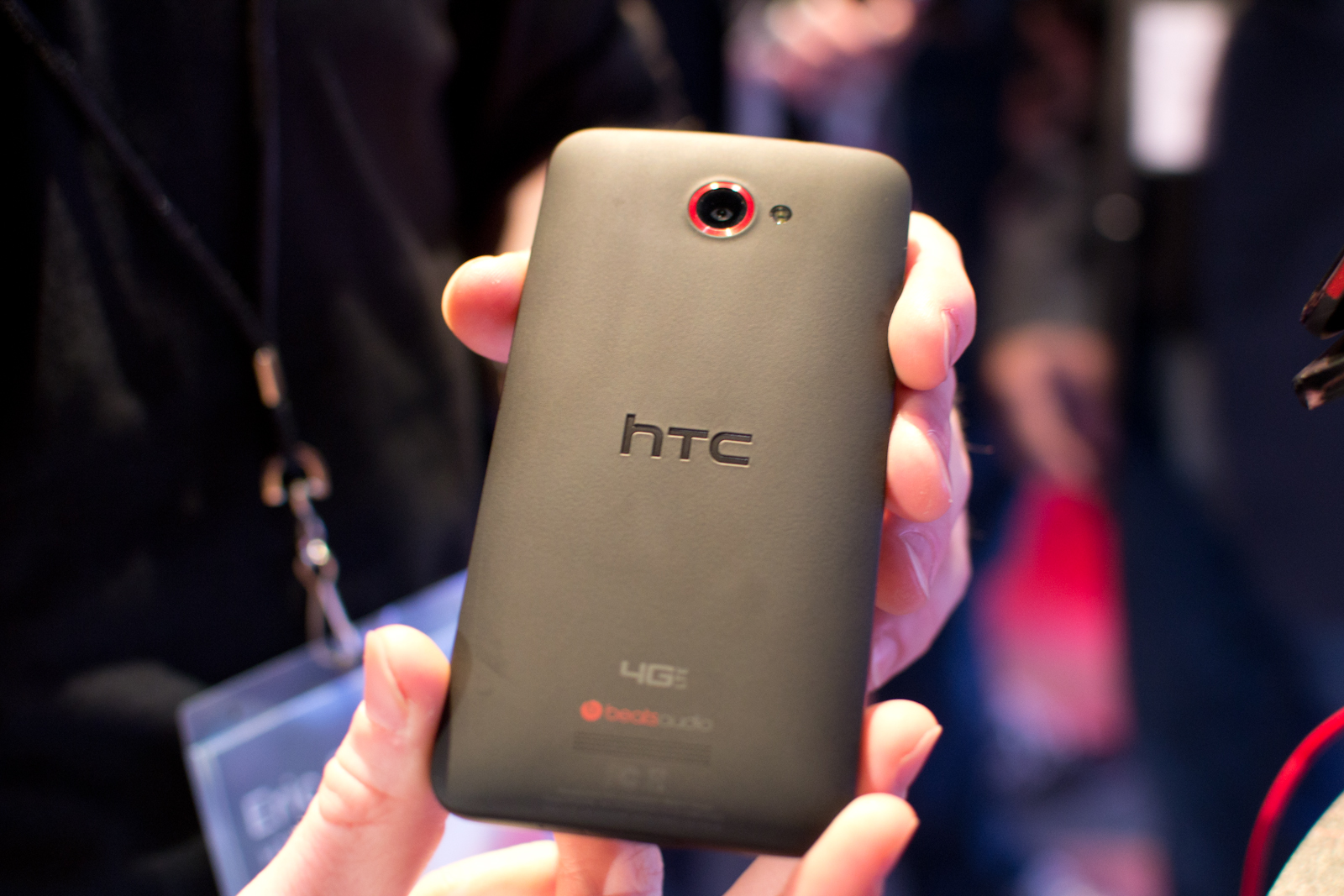HTC Droid DNA Hands-On
by Jason Inofuentes on November 13, 2012 12:22 PM EST- Posted in
- Smartphones
- Snapdragon
- HTC
- Verizon
- Mobile
- APQ8064
- droid dna
Today’s HTC Droid DNA announcement brings a few big advancements over the HTC One X that never made it to Verizon's line-up. We'll start our hands-on discussion with the most obvious change: the screen.
The Display

The rapid advance of screen technology means that we're just a year removed from the arrival of 720p displays, and just two years removed from WVGA being the defacto resolution. Today we see the efforts of Sharp’s display team come to fruition with a seemingly uncompromised 5" 1080p display. The pixel density is an unchallenged 440 ppi, and it seems to retain the brightness and fidelity of its predecessors, most recently seen in the HTC One X.

Hands-on events aren’t the place for detailed analysis, the time is too short, and the venues to cramped to pull out a colorimeter. What I will say is that the display is easy on the eyes and offers such a glut of pixels that no amount of squinting allowed me to discern. Viewing angles seemed good, with no distortion noted, and colors were bright without being oversaturated. So, at first glance, a somewhat expected excellent for the display. Here’s the thing: do we want a 1080p 5” display? At this pixel density, we would be approaching an angular subtense of two thirds of a degree. That's well below the human ability to discern at twelve inches. So is the likely battery hit worth the improved pixel density? We'll have to wait and see.
The Design

The great display is surrounded by narrow bezels all around, and the result is a body that is just 6.2 mm longer than the One X, despite the larger screen, and less than a millimeter wider. Gorilla Glass 2 is used and actually extends across the entire face of the device and forms part of the edge of the handset, a surefire sign of confidence in the strength of the glass. The effect is to make the front glass and back seem fused into one solid piece. Accent grills adorn the sides of the device, in the bright red we’ve come to expect from HTC phones on VZW. The back is a softly curving single expanse of matte black, with the HTC logo etched and inlayed in silver. An LTE logo, Beats Audio logo and the single speaker grill grace the bottom of the back, and the 8MP rear-shooter sits at the top. One particularly unique feature on the back is a concealed status LED to the left of the camera lens. When the phone is face down and a notification is received, the LED will blink to alert the user. The LED is also used to alert self-shooters when the shutter will release.

At nearly a centimeter at its thickest point, this is not the thinnest phone; but the way the back tapers down to the edge gives it an excellent in the hand feel, and makes it feel thinner than its specifications would indicate. Despite deviations from the One series design language, the solidity that defines that lineage can be seen here.
| Physical Comparison | ||||
| HTC Droid DNA | HTC One X (AT&T) | Samsung Galaxy S 3 (USA) | LG Nexus 4 | |
| Height | 141 mm (5.55") | 134.8 mm (5.31" ) | 136.6 mm (5.38") | 133.9 mm (5.27") |
| Width | 70.5 mm (2.78") | 69.9 mm (2.75") | 70.6 mm (2.78") | 68.7 mm (2.7") |
| Depth | 9.73 mm (0.38") | 8.9 mm (0.35") | 8.6 mm (0.34") | 9.1 mm (0.36") |
| Weight | 142 g (5.01 oz) | 129 g (4.6 oz) | 133 g (4.7 oz) | 139 g |
| CPU | 1.5 GHz APQ8064 (Quad Core Krait) | 1.5 GHz MSM8960 (Dual Core Krait) | 1.5 GHz MSM8960 (Dual Core Krait) | 1.5 GHz APQ8064 (Quad Core Krait) |
| GPU | Adreno 320 | Adreno 225 | Adreno 225 | Adreno 320 |
| RAM | 2 GB LPDDR2 | 1 GB LPDDR2 | 2 GB LPDDR2 | 2 GB LPDDR2 |
| NAND | 16 GB NAND | 16 GB NAND | 16/32 GB NAND with up to 64 GB microSDXC | 8/16 GB NAND |
| Camera | 8 MP with AF/LED Flash, 2.1MP front facing | 8 MP with AF/LED Flash, 1.3 MP front facing | 8 MP with LED Flash + 1.9 MP front facing | 8 MP with AF/LED Flash, 1.3 MP front facing |
| Screen | 5" 1920 x 1080 LCD-TFT | 4.7" 1280x720 LCD-TFT | 4.8" 1280x720 HD SAMOLED | 4.7" 1280x768 HD IPS+ LCD |
| Battery | Internal 7.47 Whr | Internal 6.66 Whr | Removable 7.98 Whr | Internal 8.0 Whr |
The Camera
Cameras, like displays before them, were long ignored as just value adds, and not features that must be optimized and perfected. It’s really exciting to see manufacturer’s compete for the best phone camera and not just through software trickery. HTC’s approach is, perhaps, the most traditional, and that is to provide an optical package that mimics the higher-end discrete glass you’d find on a proper SLR. The same f/2.0 28mm optics package is used here, as in the One X, and most likely the same sensor is in play. The ImageChip ISP remains a feature, and the software (now called Sense 4+) has a few additions to improve usability. It’ll be interesting to see how Sense 4+ and Android 4.2’s new camera software will play together, but for now the camera seems intuitive and the results look to match that of the One X.
The front-camera from the HTC WIndows Phone 8X finds a home here, bringing its f/2.0 optics, ultra-wide angles and 2.1MP sensor, which shoots 1080p video.
The SoC
Obviously, we’ve spent a little time with this particular SoC, recently. UI performance was smooth, and hard to trip up, even with the graphical flourishes HTC favors. The home screen carousel is no more, but cycling through home screens remains a wrap around affair and a second tap on the home button still brings an overview of all your home screens. All those flourishes render fluidly, and hopping in an out of apps and the app drawer, I didn't notice any particular hiccups. Performance should be excellent in our typical tests, based on SoC alone, but software is always a key component to the experience, and it'll be interesting to see how this S4 Pro equipped handset differs from the Nexus 4 and LG Optimus G.
The Audio
HTC has been focusing on handset audio for sometime, including their investment in and use of Beats Audio's DSP algorithms. Beats Audio remains, and there’s even a VZW tie-in with the Beats Pill, a portable Bluetooth speaker. Added to the mix is a dedicated 2.55v headphone amp, which should be able to drive even the most high-end cans. Sound quality should be improved in all headphones, and they were certainly able to power my modest earbuds well. No specifics were provided, but a dedicated amp for the rear speaker should give audio a boost there, as well. This sort of focus on audio quality is always nice to see, and we’ll be excited to put the DNA through its paces to see how it stacks up.

















54 Comments
View All Comments
JasonInofuentes - Tuesday, November 13, 2012 - link
Symbian counts!JasonInofuentes - Tuesday, November 13, 2012 - link
There are three things that you need to move phones. Good hardware, good software and great marketing. With the One X, we know that HTC can do the first two, so the last one must be the trouble, yes? The question is, does anyone that doesn't read tech blogs regularly know that HTC has an entire series of One phones? And does the maintenance of carrier specific lines dilute the mindshare effect of having a distinct core line-up?We certainly hope their sales pick-up. Competition is good, particularly when it yields hardware this sexy.
Impulses - Wednesday, November 14, 2012 - link
They really should've pushed Sprint to call the EVO 4G LTE the EVO One instead, or One EVO... Droid One for this too! Seems almost moronic but the fact that Samsung has been pounding the Galaxy S name across 3-4 carriers for nearly three years now works wonders. Even their last Nexus had the BEFORE the Nexus, that's no accident.name99 - Wednesday, November 14, 2012 - link
"There are three things that you need to move phones. Good hardware, good software and great marketing."I don't know that this is a useful typology.
An alternative viewpoint would be that phones are all about making the best TRADEOFFS possible at a particular time. Going too far down one particular path means higher prices, or reduced profit, or lower battery life.
In this particular case, at least the screen and the quad-core suggest a foolish set of tradeoffs. We'll see when the full review is done, but if the cost of a 1080 screen is lower battery life --- bad tradeoff. If quad-core has pretty much zero effect on the apps most people use --- bad tradeoff.
It's fine to claim that you personally love the screen, or use high-end games or whatever. That IS NOT THE POINT. The point is --- you sell to the mass market by making the right tradeoffs for the mass market.
Peanutsrevenge - Wednesday, November 14, 2012 - link
1080p screen is MOSTLY (IMO) a marketing move for the mass populace!Tech blog readers know that 1080p screens have a negative impact on battery life (any many of us don't see the advantage either), but most people will think it's amazing that their TV which HAD to be 1080 to be able to watch Blu-Ray and all the other mis-understandings, is now available on a phone and it must be amazing. Just like 13MP camera is obviously better than an 8Mp, or a P4 3.8Ghz is faster than an i5 2.6Ghz.....
TheJian - Wednesday, November 14, 2012 - link
Apple held their last great phones at the border for a month. When you can't sell your product in America for that long, by the time the customs let it go (infringing part had already been removed, guessing apple paid someone to keep them anyway) it was old news and everyone had caught up. They would have had the market to themselves for a month at least netting very good sales.Result:
You get a bad quarter, and Apple has a chance to sell their late phone now. See how that works? :(
Now they're hurting, when they should have sold 10 million units in a month. The OneX and EVO LTE got held up.
nafhan - Wednesday, November 14, 2012 - link
Agreed. Two contributing factors I can think of:1) Advertising, Samsung has them beat here.
2) Verizon. One series did not come to Verizon, at all. They need to go the Samsung route and present a unified set of devices across all carriers.
krushnam - Wednesday, November 14, 2012 - link
It's a mixture of a few factors that's causing so much trouble for HTC.That customs embargo must have hurt a lot.
US carriers seem to prefer pushing Samsung, Apple and even Nokia Lumias than the HTC Ones.
And of course, their marketing is no match for Sammy's huge effort on the S3.
The 3 Ones were a great strategy, that didn't get the publicity needed for success.
One thing I didn't get with the Droid DNA is that it's 9.7 mm thick.
It's Japan counterpart, HTC J Butterfly is just 9.1 mm thick, AND it has a microSD slot.
The microSD thing is also confusing... why have a slot on J Butterfly and then go remove it on the DNA?
Peanutsrevenge - Wednesday, November 14, 2012 - link
I read a comment on Phandroid relating to this a while back.The carriers don't want Sd slots in phones so people have to use the cloud for everything, causing higher data use, which they can charge for.
Makes sense when you think like a US carrier.
Thinking like... me, it's stupid. They charge high prices and cap unlimited plans because the traffic makes it unfair etc etc.... but then force people to increase data usage!
Don't know if it's right, but it did kind of make sense.
scook9 - Tuesday, November 13, 2012 - link
This looks nice but I have to voice a letdown after all the buildup....no SD card and low internal capacity, very small battery for the soc and display, built in SIM.....it is like they do not want people to buy this phone